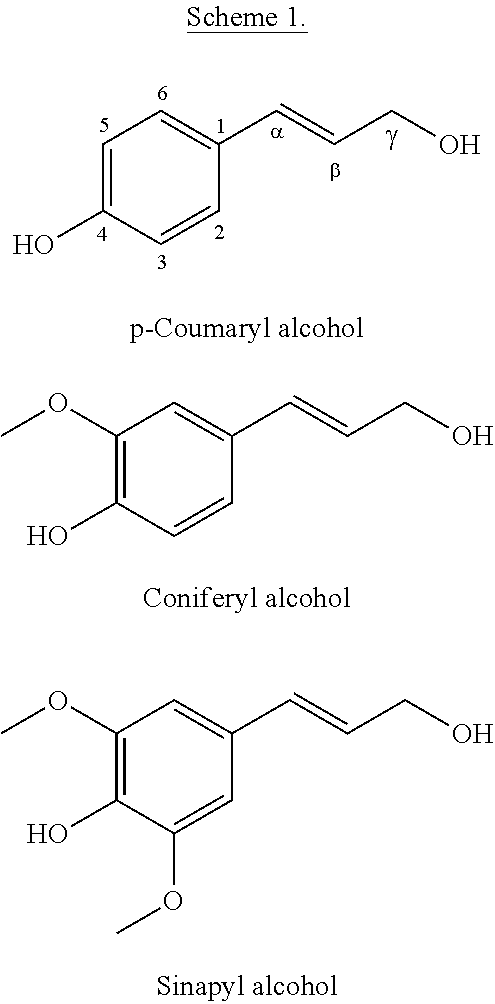Adhesive
a technology of adhesives and resins, applied in the field of adhesives, can solve the problems of resins having disadvantages, forming and emitting volatile organic compounds, and uf resins providing good strength and extremely cost competitive, and achieve the effect of promoting solubilisation and denaturisation and reducing formaldehyde emissions
- Summary
- Abstract
- Description
- Claims
- Application Information
AI Technical Summary
Benefits of technology
Problems solved by technology
Method used
Image
Examples
example 1
in:Soy MDF
[0480]Avon Gold (corn gluten meal, ca. 70% zein)(100 g) was added to water (450 mL) and then adjusted to pH 11 with 40% sodium hydroxide solution. The reaction mixture was heated to 90° C. for 50 minutes ensuring pH 11 was maintained. After 1 hour a mimosa tannin (10 g) was added and the solution stirred for 10 minutes while adjusting the pH to pH 9 with formic acid solution and reducing the temperature to 70° C. A further charge of tannin (10 g) was added and stirring continued. Glycerol (130 mL) was added followed by addition of soy flour 7B (100 g). Stirring was continued for another 50 minutes and then the solution cooled to ambient temperature. During cooling, boric acid (0.55 g) was added. The final solution was then applied as a fine spray to mechanically blended wood fibre at a rate of 8-10% adhesive content on fibre. The fibre was formed into a mattress and consolidated by hot-pressing at 180° C. to give a 8 mm medium density fibreboard (MDF) with an internal bond...
example 2
in:Soy MDF
[0481]Avon Gold (80 g) was added to water (360 mL) and then adjusted to pH 11 with 40% sodium hydroxide solution. The reaction mixture was heated to 90° C. for 50 minutes ensuring pH 11 was maintained. After 1 hour a sulfited pine bark tannin (8 g) was added and the solution stirred for 10 minutes while adjusting the pH to pH 9 with formic acid solution and reducing the temperature to 70° C. A further charge of tannin (8 g) was added and stirring continued. Glycerol (130 mL) was added followed by addition of soy flour 7B (ca. 50-52% soy protein)(80 g). Stirring was continued for another 50 minutes and then the solution cooled to ambient temperature. During cooling, boric acid (0.48 g) was added. The final solution was then applied by mechanically blending with wood fibre at a rate of 8-10% adhesive content on fibre. The fibre was formed into a mattress and consolidated by hot-pressing at 210° C. to give a 8 mm medium density fibreboard with an internal bond strength of 0.5...
example 3
nnin:Soy MDF
[0482]A lignosulfonate (30 g) was added to 70° C. water (310 mL) and adjusted to pH 11 with sodium hydroxide. Lysine sulphate (30 g) was added and after dissolving the pH was adjusted to pH 9 with formic acid. Pine bark tannin (10 g) was added and stirring continued. After adding in glycerol (120 mL) soy flour 7B (100 g) was added and stirring continued for 60 minutes. Boric acid (0.50 g) was added and the solution cooled. The brown solution was applied to wood fibre at a rate of 8-10% adhesive content on fibre and mechanically blended. This fibre was hot-pressed at 180° C. to give a 8 mm medium density fibreboard with an internal bond strength of 0.57 MPa and 24 hour cold water soak thickness swell of 21%.
PUM
| Property | Measurement | Unit |
|---|---|---|
| temperature | aaaaa | aaaaa |
| molecular weight | aaaaa | aaaaa |
| molecular weight | aaaaa | aaaaa |
Abstract
Description
Claims
Application Information
 Login to View More
Login to View More - R&D
- Intellectual Property
- Life Sciences
- Materials
- Tech Scout
- Unparalleled Data Quality
- Higher Quality Content
- 60% Fewer Hallucinations
Browse by: Latest US Patents, China's latest patents, Technical Efficacy Thesaurus, Application Domain, Technology Topic, Popular Technical Reports.
© 2025 PatSnap. All rights reserved.Legal|Privacy policy|Modern Slavery Act Transparency Statement|Sitemap|About US| Contact US: help@patsnap.com

